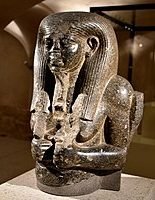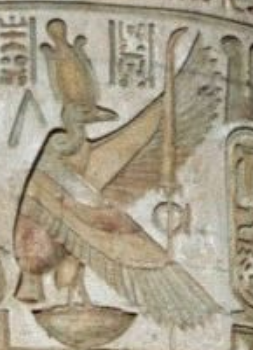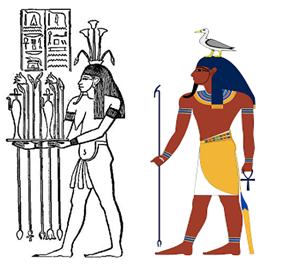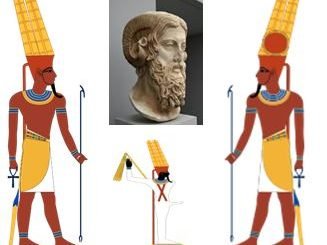Hapi: Egyptian god of the annual flooding of the Nile River
Ancient Egyptian god Hapi was venerated as the bringer of fertile soil from the Nile River. Known as “Lord of the River Bringing Vegetation”, Hapi was a benevolent deity whose gift of rich silt from the Nile enabled crops to grow bountifully. This made him an important deity in the Egyptian pantheon.
Who was the god Hapi?
God of: the annual flooding of the Nile, vegetation, rich soil
Consort: Nekhebet
Most famous cult center: Elephantine
Symbol: lotus, papyrus plants
Other name: Hep (Nile)
In Upper Egypt: Hap-Reset
In Lower Egypt: Hap-Meht
Epithets: “Lord of the River Bringing Vegetation”
Annual flooding of the Nile River
Ancient Egyptians interpreted the annual flooding the Nile as the coming of Hapi. In ancient Egyptian society, the Nile was everything. It was the cosmic life force and the home of gods. Whenever it flooded, it deposited fertile soil on the farms of the inhabitants along the river. As a matter of fact, the land of Egypt would most likely have been a barren desert had it not been for the Nile.
Importance of Hapi in ancient Egyptian religion

Egyptian god of the yearly inundation of the Nile | Image: Upper part of a statue of the Nile god Hapi. From Faiyum, Egypt, 12th Dynasty, c. 1800 BC. Neues Museum, Berlin
The flooding of the Nile was therefore seen as the Coming of Hapi. This meant that Hapi was one of the most important deities of vegetation in ancient Egypt. He ranked up there with deities like Osiris.
In some ancient texts, he was referred to as the “Father of the gods”. For without the nourishment that he offered to the people, the land of Egypt would starve and die. He was therefore seen as the deity who kept everything in the universe ticking or alive.
The above explains why he was sometimes associated with Nun, the primordial water of chaos that existed before creation.
Hapi and the Elephantine triad of gods
Standing guard at Hapi’s residence, i.e. the source of the Nile, were Elephantine family of deities Anqet (also known as Anukis), Khnemu (also known as Khnum) and Satet (Satis). The Elephantine triad of gods were responsible for determining the appropriate amount of silt that would flow downstream every year. Therefore, without the Elephantine triad of gods, Hapi and benevolent blessings could not arrive, so to speak.
READ MORE: History and Facts about the ancient Egyptian city of Elephantine
Priests of Hapi and the Nilometer
Priests of Hapi were responsible for carrying out religious rituals that beseeched the gods to keep the annual flow of the Nile at a stable rate. They would use a device known as the nilometer to measure the water level in the Nile. The device also allowed them to predict the level of the flooding.
Consort of Hapi

Hapi’s wife, Nekhbet with staff and shen ring, an ancient Egyptian symbol of eternal protection
According to some accounts, the vulture-headed goddess Nekhebet is believed to be the wife of Hapi. Nekhebet was a protective deity predominantly worshiped in the south, i.e. Upper Egypt. Her Lower Egypt counterpart was Buto, the cobra-goddess of protection in the North.
Association
Being a vegetation deity, Hapi was associated was revered as the one who nourished the cosmos and kept the universe from decaying. His association with ancient Egyptian god Geb, the deity of the earth, makes quite a lot of sense. The two deities were said to complement each other perfectly. It was even said that Hapi was a “friend of Geb”.
Hapi also had associations with deities like Neper (or Nepra), the Egyptian god of grain, and his female counterpart Nepit, the goddess of grain.
Another point worth mentioning is that ancient Egyptians often times associated Hapi with Osiris, the lord of vegetation and the underworld.

Hapi (left) was especially associated with Geb, the Egyptian god of the earth, and Neper, god of the grain
Depictions, symbols and epithets
In most depictions of Hapi, he can be seen sparsely dressed as an androgynous deity with large sagging breasts and a big stomach. This symbolizes his feminine side. For his attire, he was shown by ancient Egyptians with a loincloth and ceremonial false beard. The latter artifact was mainly reserved for Egyptian royals. Depicting with a false beard communicates his divine royalty.
To symbolize his benevolence, Hapi was shown in reliefs and other art forms presenting offering of food, fruits and vegetables. In some cases, he could be seen pouring water from jug or an amphora.
Ancient Egyptians depicted Hapi with drooping breasts and large belly to symbolize his fertility prowess and dominion over the Nile. With regard to his skin color of either green or blue, the ancient Egyptians believed that those colors symbolized water bodies.
In Lower Egypt, a papyrus plant can be seen affixed to his headdress, while a group of frogs stood beside him. In Upper Egypt, however, symbols such as crocodiles and lotus reinforced his relationship with the Nile River.
There have been some few depictions of the Nile god Hapi as a hippopotamus.

Hapi is shown here as a bearded man with sagging breasts and a large protruding belly. In Upper Egypt he is depicted with lotus plants in his headdress, while in Lower Egypt, he wears papyrus plants.
Attributes of Hapi
It was believed that without the Nile and the benevolence of Hapi, the land of Egypt would have perished.
Generally speaking, the Egyptians believed Hapi was a very benevolent god. Deriving his strength and power from the two whirlpools at his residence, Hapi’s role was to prevent hunger and starvation from entering the land of Egypt.
A symbol of union
The depiction of Hapi as an iconographic pair of genii can be seen as the union between Upper and Lower Egypt
Starting around the 19th dynasty, Egyptian painters and artists depicted Hapi as two identical people. In both hands they wielded two plants – representation of Lower and Upper Egypt. The two figures can be seen tying those two plants together. Hapi was therefore seen as a deity who united the two Egypts so to speak. Such depictions of him appeared in the tombs or on the statues of the pharaohs.
Worship and offerings
His worship was very prominent at the First Cataract of the Nile River, i.e. located around Elephantine.
Every time there was flooding of the Nile, the ancient Egyptians believed that it was Hapi making contact with the people of Egypt. Offerings of all manner would then be thrown into the Nile to ask for Hapi’s continued blessings.
Read More:
- Myths and Facts about Seth, the god of chaos and the desert
- Nephthys – the Egyptian Goddess of Death and the Night
Hapi’s residence
Ancient Egyptians believed that Hapi had his residence at a cavern around the source of the Nile. At the time, they believed that his residence was near Aswan, a city in the south of Egypt.
References
- Desmond Stewart, Wonders of Man The Pyramids and the Sphinx pg.99
- Wilkinson, Richard H. (2003). The Complete Gods and Goddesses of Ancient Egypt Thames & Hudson



























